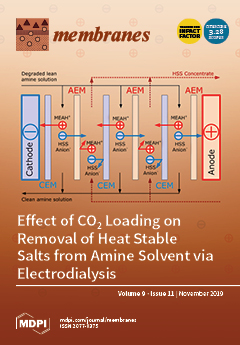Filtration membranes (FMs) are an integral part of electrodialysis with filtration membranes (EDFM), a green and promising technology for bioactive peptide fractionation. Therefore, it is paramount to understand how physicochemical properties of FMs impact global and selective peptide migration to anionic (A
−
[...] Read more.
Filtration membranes (FMs) are an integral part of electrodialysis with filtration membranes (EDFM), a green and promising technology for bioactive peptide fractionation. Therefore, it is paramount to understand how physicochemical properties of FMs impact global and selective peptide migration to anionic (A
−RC) and cationic (C
+RC) peptide recovery compartments during their simultaneous separation by EDFM. In this context, six polyether sulfone (PES) membranes with molecular weight cut-offs (MWCO) of 5, 10, 20, 50, 100 and 300 kDa were characterized and used during EDFM to separate peptides from a complex whey protein hydrolysate. Surface charge, roughness, thickness and surface/pores nature of studied PES membranes were similar with small differences in conductivity, porosity and pore size distribution. Interestingly, global peptides migration to both recovery compartments increased linearly as a function of MWCO. However, peptide selectivity changed according to the recovery compartments and/or the peptide’s charge and MW with an increase in MWCO of FMs. Indeed, in A
−RC, the relative abundance (RA) of peptides having low negative charge and MW (IDALNENK and VLVLDTDYK) decreased (45% to 19%) with an increase in MWCO, while the opposite for peptides having high negative charge and MW (TPEVDDEALEK, TPEVDDEALEKFDK & VYVEELKPTPEGDLEILLQK) (increased from 16% to 43%). Concurrently, in C
+RC, regardless of MWCO used, the highest RA was observed for peptides having low positive charge and MW (IPAVFK & ALPMHIR). It was the first time that the significant impact of charge, MWCO and pore size distribution of PES membranes on a wide range of MWCO was demonstrated on EDFM performances.
Full article






